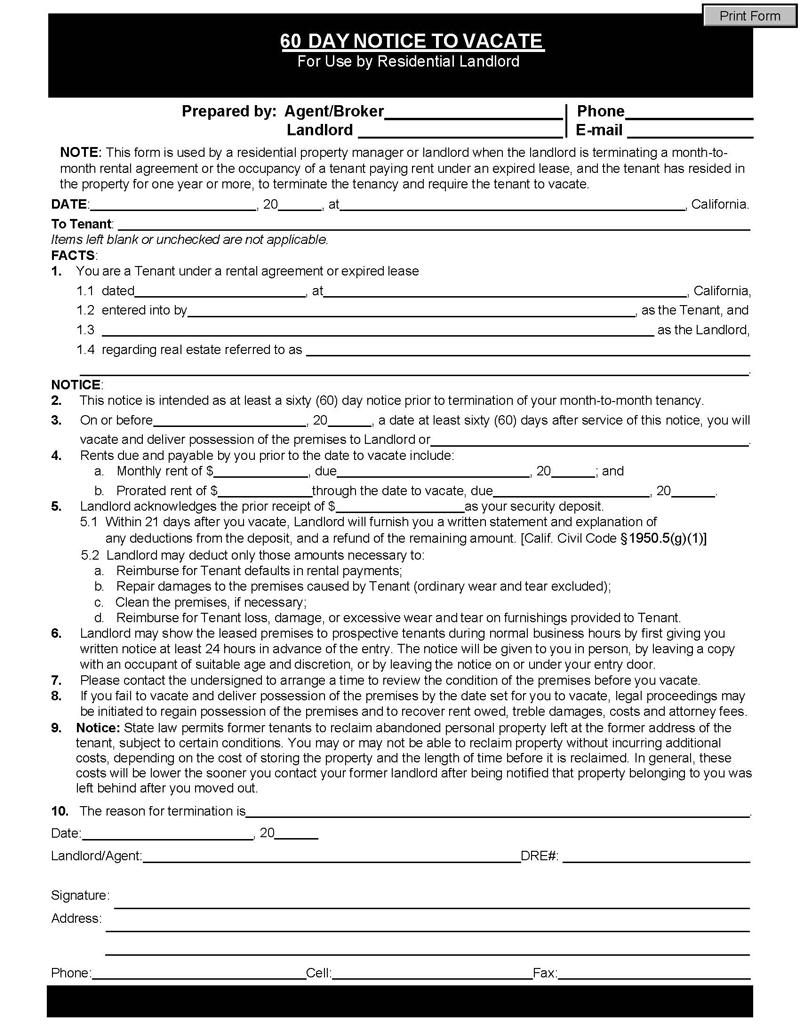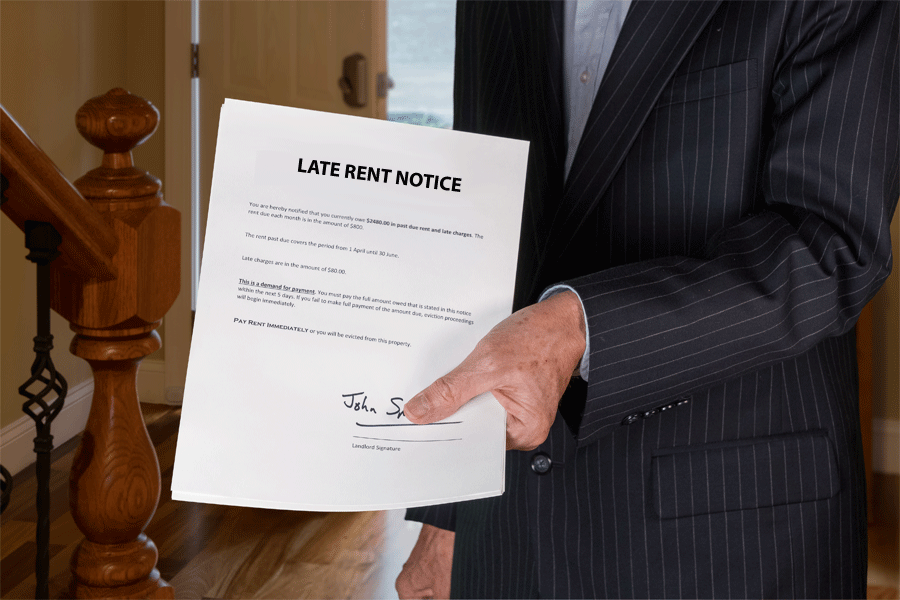A California lease termination letter is a written notice informing a tenant that they must leave the rental property within a specified time frame because the landlord will end the lease.
A landlord can terminate a lease due to just cause, such as a tenant violating the rental agreement terms, or a no-fault reason, such as reclaiming the property for occupancy or conversion. Terminating a fixed-term lease requires just cause, while landlords can end month-to-month tenancies with or without one. Whatever the case, the landlords must explain the reason for eviction and give the tenants enough time to find new housing and vacate the property.
Serving the notice in writing is also necessary if the landlord decides to take legal action if the renter doesn’t comply. As for tenants terminating a rental lease agreement in California, a termination letter gives the landlord time to find a new renter and avoid losing a month’s rent.
California Lease Termination Letter Form

Importance of California Lease Termination Letter
Lease agreements are legally binding contracts between landlords and tenants, specifying the terms for renting a property and outlining each party’s rights and obligations.These rental agreements can cover month-to-month tenancies and long-term leases (fixed-term, typically lasting 12 months, but six-month and 18-month leases are not uncommon).
Signing a lease doesn’t prevent a tenant from violating its terms, but they’d have to face the consequences. Unfortunately, few landlords will turn a blind eye to irresponsible tenant behavior, and most take the eviction road.However, they can’t do it constructively or lock a tenant out under the California landlord-tenant laws. Instead, they must write a California lease termination letter to give the renter a notice to fix the problem or vacate the premises.
A tenant can also terminate the lease early for many reasons in California, and they must notify the landlord through a termination letter. Some situations don’t require written notice, but more on that later.
Termination Notice Requirements
Termination notice requirements are different for landlords and tenants and depend on the length of time a renter has lived in a property:
For landlords
A landlord can terminate a month-to-month tenancy or a fixed-term lease if a tenant has violated the rental agreement terms. However, they must give a three-day notice if the reason for eviction is fixable. Depending on the problem, they can give:
A pay or quit notice
This form notifies the tenant they must move out if they don’t pay the rent within three days, starting from the day after receiving it.
A cure or quit notice
This document aims to try and fix a particular lease violation, informing the tenant they must vacate the premises if they don’t perform covenant(s) within three days. The issue may be bringing an authorized roommate, smoking in a non-smoking unit, not respecting a no-pets policy, engaging in illegal activities, etc.
However, a landlord may decide to end a month-to-month tenancy without giving the tenant a chance to fix the issue. They must send a 30-day or 60-day notice, depending on how long the tenant has been renting the property.
If a tenant has lived in a rental for less than 12 months
California’s rent control laws cover rent and eviction control for most residential tenancies. However, tenants renting a property for less than a year don’t enjoy the same protection as those with longer occupancies. The tenants have less time to make new accommodation arrangements if their landlord asks them to move out.
The landlord must give at least 30-days’ notice. Depending on the parties ‘ agreement, the period can be longer or shorter (not less than seven days). The landlord must give the tenant written notice personally or via certified or registered mail, ensuring it contains the following statement verbatim under the California Civil Code Section 1946.1:
“State law permits former tenants to reclaim abandoned personal property left at the former address of the tenant, subject to certain conditions. You may or may not be able to reclaim property without incurring additional costs, depending on storing the property and the length of time before it is reclaimed. Generally, these costs will be lower the sooner you contact your former landlord after being notified that property belonging to you was left behind after you moved out.”
If a tenant has lived in a rental for 12 months or more
The California Tenant Protection Act of 2019 prevents a landlord from evicting a tenant who has resided in their rental for at least a year without just cause. This can include tenant at-fault behavior or no-fault reasons.
At-fault behaviour can include:
- Not paying the rent
- Violating the lease after receiving a written notice to correct a specific issue
- Damaging the rental property
- Committing, permitting, or maintaining a nuisance
- Subletting the property in violation of the rental agreement terms
- Engaging in criminal activity or making a criminal threat on the property
- Not allowing the landlord a lawful entry under the California Civil Code Section 1101.5 (Property) and Section 1954 (Obligations)
- Refusing a lawful entry under the California Health and Safety Code Section 13113.7 (Fires and Fire Protection) and Section 17926.1 (Housing)
- Not signing a new lease like the expired one after receiving the landlord’s request or demand (mobile homes only)
No-fault reasons for eviction can include:
- Reclaiming the property for occupancy by the owner, their family, or relatives
- Removing the property from the rental market
- Vacating the unit by order of a court or government agency due to violating health or safety codes
- Remodeling or demolishing the property
Whatever the reason for eviction, a landlord must give at least 60-days’ notice if their renter has occupied the unit for more than 12 months.
They must provide relocation assistance if the tenant is not at fault regarding the lease termination. In addition, they can either provide a month’s rent or waive the final month’s rent.
For tenants
Tenants in California must give a 30-day notice to terminate a month-to-month tenancy or a fixed-term lease. Their rental agreement specifies the date for notifying the landlord about leaving (the first day of the month or another date).
The tenants must pay the rent for the final month if they are at fault, but they might be able to avoid paying the remaining rent of a fixed-term lease in the following situations:
- The property violates the California Health and Safety Code
- The tenant has joined active military service
- The landlord has harassed the renter or violated their privacy rights
- The tenant is a victim of domestic violence, sexual assault, stalking, human trafficking, or other specified crime (the same goes for their immediate family members or household members).
A tenant can also move out without notice if the unit is unsafe and uninhabitable. That can include:
- Unsanitary conditions
- Mold
- No running water, heating, waterproofing, or ventilation
- Faulty electricity, gas, or plumbing systems.
How to Terminate a Lease Agreement?
Terminating a lease agreement in California may include one to four steps, depending on how your tenant responds to their eviction notice:
Serve a notice
Landlords can serve a notice in three ways, but the eviction deadline depends on the notice type, including a three-day pay or quit notice, a three-day cure or quit notice, and a 30- or 60- day termination notice.
It is vital to note that weekends and court holidays don’t count toward the three-day notice period and the five-day deadline for responding to a lawsuit. Tenants can either give a lease termination letter in person or deliver it by certified or registered mail to the landlord or their agent in California.
Personal service
Handing California’s lease termination letter in person is the fastest way to inform your tenant about a potential or definite eviction. In addition, it allows you to discuss the problem face to face and find a solution if there’s anything the renter can do to stay, such as pay the rent or replace a damaged item.
Substitute service
In California, you, as a landlord, can hand the termination letter to an adult who isn’t on the lease if you can’t reach the tenant. That adult must be on the premises or at the renter’s workplace. Using a substitute service also requires mailing a copy of the notice to the tenant. The eviction period starts once they receive both.
Posting and mailing
If, as a landlord, you’ve tried delivering the notice personally or via a substitute service to no avail, you can post it on the rental unit’s front door. You also must send a copy to the tenant by certified or registered mail. This method is known as the ‘posting and mailing’ or ‘nailing and mailing’ method.
File the case
You, as a landlord, can’t forcefully remove the tenant from the rental if they don’t comply within the specified deadline; only a sheriff can.
However, you can file an eviction case (unlawful detainer). It’s a lawsuit stating that your tenant is occupying the unit illegally. It can help you evict them and receive back rent. The tenant must file a response in court within 5-15 calendar days, depending on how you served them the lawsuit. They have five days to respond if you delivered it in person and 15 days if you used a substitute service.
You can only post and mail a copy of the lawsuit after three failed attempts to serve it personally or by substitute service. After that, you’d have to get a court order first, and the tenant would have 15 days to respond.
Request a default judgment
If the tenant doesn’t appear in court within the specified deadline, you (landlord) can request a default judgment by filing a request for entry of default.
That means asking a judge to rule the case in your favor without a hearing, preventing the tenant from fighting it in court. It typically takes 3-10 days to process the request, but it can be longer if the judicial officer has a heavy caseload.
However, if the tenant contests the lawsuit, the court will schedule a hearing within 10-30 days upon receiving the request.
Obtain a writ of possession
If you win the case, a judgment of possession will be granted to you (landlord). You’ll need it to apply for a writ of possession– a court order enabling the sheriff to forcibly remove the tenant from the property if they don’t respect the judge’s ruling within the specified time frame.
Your tenant will have a specific period to move out, but the sheriff will step in if they still refuse to go peacefully after the deadline. The entire process can take 5-25 days.
note
The California eviction process can be time-consuming and arduous, lasting between 21 and 100 days, but it can drag on even longer. However, if a tenant doesn’t contest the case, the average eviction time is 45 days, while it typically takes 75 days to remove them from the premises if they fight the lawsuit.
Conclusion
Terminating a lease in California and evicting a tenant if they refuse to leave can be daunting, especially if they resort to tactics to delay the proceedings, such as filing a motion to strike or filing for bankruptcy. Still, if you follow the steps above, you’ll resolve the issue eventually, even if it takes months to repossess your property and receive back rent.











